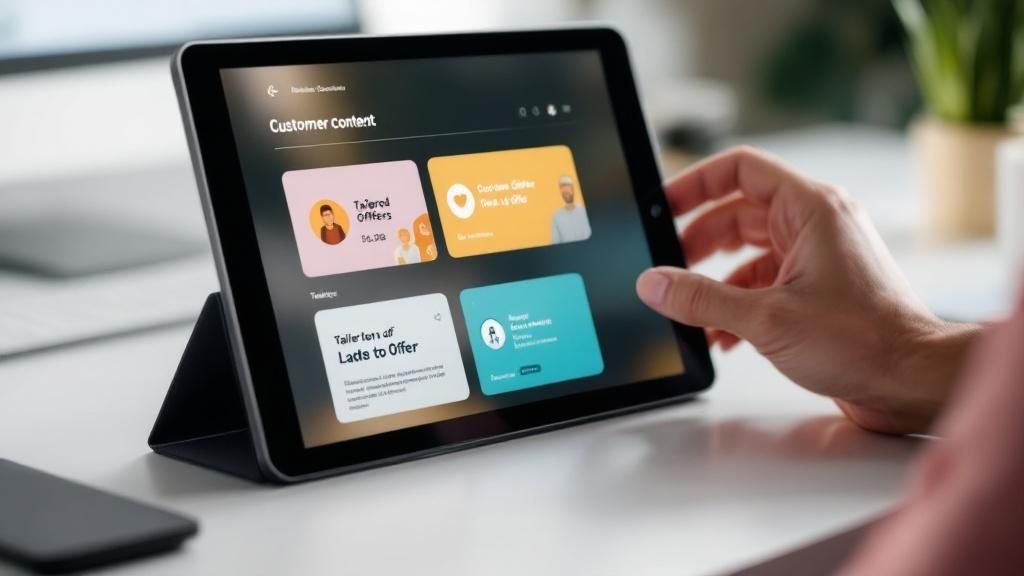Navigating Today's Customer Engagement Reality

Let's be real—managing customer engagement feels like a completely different job than it did a few years ago. Today's customers don't just appreciate a personal touch; they expect it at every turn. Sending out a generic, one-size-fits-all message doesn't just get ignored; it can actively harm your brand's reputation.
This isn't just a feeling; it's a massive technological shift in progress. By 2025, AI is expected to power 95% of all customer interactions, meaning 19 out of 20 touchpoints will have AI assistance. This completely changes how we approach customer engagement, moving us from manual check-ins to automated, intelligent conversations. You can see more details in this complete report on customer engagement statistics. Our strategies have to adapt, or we risk getting left behind.
Interestingly, the challenge of building real connections through a screen isn't just for customers. It reflects the same difficulties many companies have keeping their own teams connected. The core ideas for building strong digital relationships are universal. You can explore this parallel further by learning about how to engage remote employees.
Shifting From Outdated To Outstanding
This new environment requires an honest look at what works and what's holding you back. Too many teams are still using an old playbook for a brand-new game.
To see this change in action, it helps to compare the old methods with the new ones. The table below provides a comparison of traditional engagement approaches with modern digital-first strategies.
| Engagement Method | Traditional Approach | Modern Approach | Effectiveness Rating |
|---|---|---|---|
| General Communication | Mass email blasts, generic newsletters | Segmented, behavior-triggered campaigns | High |
| Customer Support | Phone-only support, long hold times | Omnichannel support (chat, AI, social media) | Essential |
| Product Feedback | Annual surveys, passive suggestion boxes | Real-time, in-app prompts, sentiment analysis | High |
| Onboarding | A single "welcome" email | Personalized, multi-step journey with tutorials | High |
The difference is night and day, isn't it? The modern approach isn't just about using new software; it's a completely different philosophy that puts the individual at the center. Instead of broadcasting messages at an audience, the aim is to start a two-way dialogue that feels personal and helpful.
This is where great companies truly separate themselves. They don't just react to problems; they anticipate customer needs based on their behavior.
For example, imagine a customer repeatedly visits a specific feature page on your website. The traditional method does nothing with that information. The modern method automatically triggers a helpful message, offering a quick video tutorial or a case study about that exact feature. This small, proactive gesture transforms a simple browsing session into a meaningful engagement, building trust and showing you're paying attention.
Turning Customer Data Into Engagement Gold
It feels like every company is sitting on a mountain of customer data, yet we're all struggling to find the real gems. We collect the basics—names, locations, maybe a job title—but we often miss the clues that actually drive engagement. When 80% of customers tell us the experience you provide is just as important as your product, you realize that just knowing their name isn't enough. The real magic happens when you turn those scattered data points into a clear, actionable picture of your customer.
From Raw Data to Rich Behavioral Profiles
This is where a behavioral profile comes in. It’s a shift from looking at who a customer is to understanding what they do. Think of it as the story behind the contact record, pieced together from their actions: what they buy, how they browse your site, the questions they ask support, and the content they read. This is what separates a generic, mass email from a message that feels like you're reading their mind.
Let's say you sell marketing automation software. A standard profile tells you: "Jane Doe, Marketing Manager, Basic Plan." That’s not much to go on. But a behavioral profile gives you the full story:
- Jane logs in a couple of times a week, but she only ever uses the email builder.
- She hasn’t touched the social media scheduling tool.
- She recently spent ten minutes reading your blog post on "A/B Testing Best Practices."
- Her last support ticket was about a CRM integration.
Now you have a playbook. Instead of a bland "feature update" email, you can send Jane a guide on getting more from her A/B tests or a case study about that exact CRM integration she asked about. This is proactive, value-driven engagement, and it's all based on the signals she's already sending.
Practical Ways to Gather Actionable Insights
The best part is, you don’t need to send out invasive surveys to get this information. You can build these rich profiles just by paying attention to the interactions that are already happening. The real work is connecting the dots between your different data sources instead of letting them live in separate silos. Smart companies usually focus on a few key areas to get started.
Your support desk is an absolute goldmine. A company like TTEC, for instance, managed to automate up to 40% of its customer interactions simply by analyzing common support tickets. This didn't just cut down on repetitive work; it revealed opportunities to educate customers proactively. In the same way, tracking in-app or on-site behavior shows you which features people actually use and which ones they ignore, helping you guide them toward getting more value from your product.
Ultimately, the goal is to create a complete picture. Managing customer engagement effectively means listening to everything your customer tells you—not just with their words, but with their clicks, their purchases, and their questions. This deep understanding is the foundation for creating experiences that build real loyalty and drive growth.
Orchestrating Seamless Multichannel Experiences
Your customers don't see your company in silos like "email marketing" or "social media." To them, it's all just your brand. When your tone on Twitter feels completely different from your support emails, it creates a jarring and disconnected experience. True managing customer engagement is about crafting a single, fluid conversation that moves naturally between platforms. Think of it like talking to a friend—the conversation doesn't reset just because you moved from the living room to the kitchen.
Adapting Your Voice Without Losing Your Identity
Being consistent doesn't mean you have to sound like a robot. The key is to maintain a consistent brand voice (your company's core personality) while flexing your channel tone to fit the environment. Your voice might be "helpful and expert," but the tone needs to shift based on where you're talking and what people expect there.
- Email: This is a more personal space, so you can be helpful, clear, and a bit more detailed.
- Social Media: Here, you're competing for attention. Be more casual, concise, and conversational. Using emojis or GIFs can feel right at home.
- In-App Message: Your user is already focused on a task, so be direct, action-oriented, and brief.
The goal is simple: a customer should always feel like they're interacting with the same company, just in a different setting. A playful tweet and a professional support email can both come from a brand that is fundamentally friendly and competent.
Mapping the Customer Journey
So how do you actually make this happen? You need a map. Visualizing the customer's journey is the only way to ensure each touchpoint flows logically into the next. Modern marketing tools are designed for exactly this. For instance, take a look at this automation builder from Mailchimp.

This kind of visual workflow shows how a trigger, like a customer making a purchase, can kick off an entire sequence: wait a few days, send a follow-up email, and then tag them for a future campaign. This is powerful because it turns random interactions into a thoughtful, cohesive experience that builds loyalty over time.
One last piece of advice: don't try to be everywhere at once. It’s a common mistake that stretches teams too thin. Use your data to find the two or three channels where your customers are most active and start there. A flawless experience on two platforms is far more valuable than a mediocre presence on ten.
Mastering The Art Of Real-Time Customer Connection
The expectation for instant answers has totally shifted how we do business. Customers don't just appreciate speed; they see it as the standard. But throwing more tech at the problem isn't the silver bullet. The real skill is in finding that sweet spot between automated efficiency and a genuine human touch.
Getting this balance right is critical. The modern customer experience is a bit of a tightrope walk, where one wrong move can be costly. Research shows that 72% of customers expect immediate service, and a jaw-dropping 52% will jump to a competitor after just a single bad interaction. You can dig into more customer experience insights from this report. This isn't just about being fast; it's about being fast and effective.
The Human vs. Bot Dilemma
So, when do you let a chatbot take the lead, and when is a human agent absolutely essential? The best way to think about it is as a smart triage system. Automation is your first line of defense, ideal for handling repetitive, simple tasks that eat up time. This frees up your team to focus on work that requires a human brain.
- Deploy chatbots for: Answering common questions like "What are your business hours?", checking an order's status, booking a basic appointment, or collecting initial customer details. They can handle predictable queries with speed and accuracy, 24/7.
- Reserve human agents for: Tricky troubleshooting that requires some digging, managing emotionally charged conversations, walking a prospect through a personalized sales quote, or untangling a sensitive billing issue. These moments need empathy and creative thinking—things no bot can fake.
Building A Seamless Escalation Path
Nothing is more frustrating for a customer than getting stuck in a loop with a chatbot that just doesn't understand. That's why a smooth escalation process is the backbone of any real-time support strategy. The goal is to make the handoff from bot to human feel like a helpful next step, not a system failure.
A great escalation path means the chatbot has already gathered the customer's name, account number, and a quick summary of the problem. When the human agent jumps in, they have the full chat transcript and all the context. They can get straight to solving the issue without making the customer repeat everything—a huge source of friction. For more ideas on improving these interactions, check out our guide on how to increase client engagement.
Ultimately, mastering real-time connection means turning quick service into a moment of genuine engagement. It’s about showing customers you respect their time and have your act together. This simple display of competence is what builds solid trust and keeps them coming back.
Building Loyalty Programs That Actually Work

Let's be honest, the old "buy nine, get the tenth free" punch card is feeling a little tired. While transactional rewards have their place, the most successful loyalty programs today are built on something much stronger: a genuine sense of connection and community. The goal isn't to cheapen your brand with constant discounts but to make your customers feel like they're part of an exclusive club.
These programs transform customers from simple buyers into true brand advocates. They stop being about what you can get and start being about who you are—a member of a community that shares your values and gives you special status.
Moving Beyond Transactional Rewards
The key is to shift your thinking from what you can give customers to what you can let them experience. You want them to feel like insiders, not just numbers on a spreadsheet. Instead of another 10% off coupon, think about offering perks that create real value and a feeling of exclusivity.
This could look like:
- Early access to new product launches before the general public.
- Invitations to members-only Q&A sessions or webinars with your leadership team.
- Exclusive content, like behind-the-scenes videos or in-depth guides.
- Access to a private online community where they can connect with peers and your team.
Building this kind of community isn't passive; it requires real, active participation. Fostering a lively conversation across your social channels is a great way to make that happen. If you need some ideas, you can find some helpful Twitter engagement tips to get the ball rolling. When done right, the reward is no longer a discount—it's the feeling of belonging.
Designing Rewards and Intervening with Care
The best loyalty programs aren't built on guesswork; they're built on data. By paying attention to how your customers use your product, you can uncover what they truly value. Who are your power users? Which features do they rely on every day? What content do they engage with most? This information is a goldmine for creating personalized perks that show you're paying attention.
This same data is your early warning system for customers who might be at risk of churning. A sudden drop in login activity or a cluster of support tickets can signal that someone is struggling. The trick is to intervene in a way that feels supportive, not desperate. Forget the generic "We miss you!" email. Instead, try sending a targeted message offering a one-on-one session to help them overcome a specific hurdle.
This focus on retention is quickly becoming a core growth driver for many businesses. As we look toward 2025, keeping existing customers happy is more critical than ever, especially as acquisition costs rise. For a real-world example, look at Allergan Aesthetics. They drove over $400 million in revenue by relaunching their loyalty program, Allē, which is centered on personalized communication and relevant rewards. You can explore more about these 2025 engagement trends to see how others are succeeding.
To get a clearer picture of how different retention efforts can impact your bottom line, it's helpful to compare their potential return on investment.
Customer Retention Strategy ROI Analysis
Comparison of investment costs and returns for different retention strategies
| Strategy Type | Implementation Cost | Time to ROI | Average Return | Customer Satisfaction Impact |
|---|---|---|---|---|
| Points-for-Discounts Program | Low | 1-3 Months | Low | Low |
| Tiered VIP Program (Experiential) | Medium | 6-9 Months | High | High |
| Proactive Churn Intervention | Low-Medium | 1-2 Months | Very High | Medium-High |
| Community Building (Forums/Events) | Medium-High | 9-12 Months | Very High | Very High |
As the table shows, while simple discount programs are quick to implement, their impact is often minimal. The strategies that deliver the highest returns and a significant boost in customer satisfaction—like proactive intervention and community building—are the ones that focus on building relationships.
Of course, a loyal customer base starts with attracting the right people from the beginning. This is a vital first step, which you can read more about in our guide to B2B sales lead generation. Ultimately, effective loyalty programs are the natural outcome of a customer-centric approach, from the very first interaction to the hundredth purchase.
Measuring What Actually Moves The Needle
After putting in the hard work to build loyalty, the last thing you want to do is measure your success with the wrong yardstick. It's so easy to get caught up in vanity metrics—the likes, shares, and email open rates that feel good but don't tell you much about your business's health. True managing customer engagement is about looking past these surface-level numbers and focusing on what actually affects your bottom line.
A fancy dashboard might look impressive, but it’s the actionable insights that keep the lights on. Instead of just tracking activity, successful companies track results. This means focusing on metrics that can actually predict future revenue and customer behavior. When you learn that organizations with higher customer loyalty deliver 3.5 times more cumulative shareholder return, you realize how critical it is to get this right. You need a system that reveals the real-world impact of your efforts.
Key Metrics That Drive Strategy
So, if not likes and shares, what should you be tracking? It boils down to measuring the long-term health of your customer relationships, not just one-off interactions.
- Customer Lifetime Value (CLV): Think of this as the ultimate engagement score, not just a number for the sales team. CLV tells you the total revenue you can expect from a single customer over time. If your CLV is climbing, your engagement strategy is working. It's that simple.
- Engagement Momentum: Don’t just look at a single snapshot in time. Are your customers becoming more involved with your brand, or are they slowly drifting away? By tracking the frequency and depth of their interactions, you can spot trends that a single metric would completely miss.
- Product Adoption Rate: This is pure gold, especially for SaaS businesses. Are your customers using the core features you built for them? High adoption is a direct sign that they see value in what you offer and a strong indicator that they’ll stick around.
Tracking these numbers gives you a direct feedback loop between your actions and your results. You can try out a new onboarding sequence or send a personalized check-in email and see precisely how it affects CLV or product adoption. This turns measurement from a boring reporting task into a powerful tool for growth. It helps you justify your acquisition spending, particularly if you automate lead generation to bring in new customers efficiently. Ultimately, understanding these trends is the foundation you need to build customer loyalty in a way that truly grows your business.
Your Engagement Strategy Implementation Roadmap
So, you know what data to look at. That’s a great start, but the real challenge is putting those insights into motion. A strategy is just a document until you have a solid plan to bring it to life. This roadmap will walk you through moving from a small, controlled test to a full-scale rollout, helping you make smart changes that get results without breaking what already works.
Phasing Your Rollout for Maximum Impact
Trying to change everything for everyone all at once is a surefire way to create chaos. Instead, approach this like a scientist and pilot your new engagement tactics with a specific customer segment. Think about a small, manageable group, like new customers from a particular industry or users who have shown interest in one of your key features. This approach lowers the risk and gives you a safe space to learn and tweak your strategy before launching it company-wide.
Before you start, you'll need some internal backup. You don't need everyone on your side right away. Pull together a small, focused "tiger team" with people from sales, marketing, and customer support. This group will act as your champions, helping to iron out any early wrinkles and prove the value of the new approach. Their success will be the best argument for getting the rest of the company on board.
A great pilot program creates a repeatable process for every customer, from the very first touchpoint all the way to collecting feedback.

As you can see, managing customer engagement is a continuous loop, not a one-time project. What you learn from customer feedback should directly shape and improve your next round of engagement efforts.
Scaling Success and Maintaining Momentum
Once your pilot starts showing positive results, you’re ready to scale. The key here is to document everything that worked and, just as importantly, what didn't. This documentation becomes the official playbook you'll use to roll out the strategy to all your customers.
Keeping your team motivated during a big rollout is essential. Make sure you celebrate the small wins along the way. Did the pilot program increase feature adoption by 5%? Share that news! It keeps everyone energized and focused on the goal. When you inevitably hit a roadblock, treat it as a learning moment to improve your playbook, not a failure. This mindset is what separates strategies that last from those that lose steam.
A solid roadmap needs a powerful engine. When you’re ready to scale your outreach and turn your plan into a pipeline, an automated platform becomes a necessity. Salesloop.io helps you execute your engagement sequences flawlessly, making sure your message gets to the right person at the perfect time.





